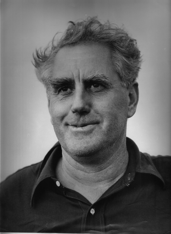
Uffa Fox was born in 1898 on the Isle of Wight and grew up in Cowes. He was apprenticed to the boatbuilders S E Saunders for seven years and learnt the skills of boatbuilding, shipbuilding and design. At the age of 21 he set up his own boat building business. He acquired an aged ‘floating bridge’ which had linked Cowes to East Cowes. The central part provided a workshop, the prow at one end formed a gangway to the shore, and the other end became a slipway. The accomodation was converted to a drawing room and living space. Uffa had a free and adventurous spirit. As a Scout Master, on one occasion, he decided that it was time to “blood” the troup. With a crew of 10 scouts, sworn to secrecy, and told to tell everyone they would be camping in the Solent area, they tried to reach Paris via the Seine. On returning home, Uffa was charged with irresponsibility and placing young lives in jeopardy – needless to say, he remained a legend to those scouts. It turned out they had turned back only 20 miles short of Paris.
Uffa was the father of the planing dinghy and believed that if a dinghy hull were made the
right shape, and her crew held her upright, she could be made to plane. He first gave his theories full rein in the International Fourteen-Footer Avenger. In 57 starts in 1928 she gained 52 first places, two seconds and three thirds including winning the coveted Prince of Wales Cup.
Uffa came up with many new designs and was always ready to prove them with a practical demonstration. People grew accustomed to his eccentricities, and he raised some eyebrows when he took off across the English Channel in a two-man sliding seat canoe, Brynhild, with his crew (also his chief draughtsman) Bill Waight.
During the second world war he designed the Airborne Lifeboat, a vessel carried beneath aeroplanes and dropped by parachute to survivors of ditched aircraft. Lightly built, with lines that blended to the shape of the planes, the Airborne's had sails, engine, survival kit and instructions on how to sail. Many aircrews owed their lives to this invention and despite all his success in the field of yacht racing he maintained that this was his most fulfilling design.
Immediately after the war he was closely associated with Fairey Marine of Hamble who built hot moulded boats to his designs. Included in the impressive list were International Fourteens, Firefly, Swordfish, Albacore, Jolly Boat, Duckling and the cruiser Atalanta.
Uffa’s association with royalty brought his name to the broad mass of the British public. He and the Duke of Edinburgh raced together on the Dragon Bluebottle, and with Uffa as crew, they were also prominent at Cowes Week in the Flying Fifteen, Coweslip. This 20-foot keelboat was one of Uffa’s most successful post-war designs.
Out of the Flying Fifteen design came a wave of inspiration, producing planing keelboats from the Flying Ten through to the Flying Twenty Five. Us similar hulls he produced a range of cruiser/racer yachts from the Flying Twenty Five through to the Flying Fifty. (The Flying Thirty and Thirty Five designs actually planed in the right conditions!)
Uffa married three times. His first wife was Alma who played a large part in his early career including preparation of much of his five pre-war books. In 1941 he married Cherry and then in 1956 a French lady Yvonne Bernard. This was an interesting match as Uffa spoke no French and Yvonne no English! His last residence was the Commodore’s House, overlooking Cowes harbour. It is a 300-year-old warehouse with its own quay. Designed specifically for his old age he had a lift fitted serving all three floors and the roof garden.
In the 1960s Uffa became associated with the American yachtsman and boat builder George O’Day. This liaison resulted in the Daysailer and Javelin which were his most numerous classes. The last boat Uffa designed was for his own use, a 25-foot launch Ankle Deep, and his last excursion on the Solent was in her to watch the start of the 1972 Tall Ships Race.
Uffa died in October 1972. Trinity Church at Cowes was packed for the service and a memorial service at St Martin In The Fields London was equally packed and attended by amongst others the Duke of Edinburgh. He is remembered not merely as a yachtsman and designer, but as a writer, philosopher and character the likes of which are rare.
The origins of the Flying Fifteen as legend has it, were that one evening, all those years ago, as he lay in his bath at home in Cowes, Uffa had a vision of a radical new small boat; of the FLYING FIFTEEN in all her glory marching in triumph before a stiff nor'wester. He rushed from bath to drawing board and put the vision on paper there and then - the hull, the keel, the rudder, the sail plan.
What would Uffa think of his Flying Fifteen now? After fifty plus years of changing ideas and technologies, the boat that is built and raced now is rather different. In the1960s aluminium spars, cold moulded hulls and terylene cloth made their impact. In the 1970s GRP hulls became the norm and, in the '80s and '90s, new materials and techniques allowed still further developments to take place.
In the 1960’s, the generous measurement tolerances in the original rules were being exploited to give more boat speed. Uffa and many of his contemporaries felt strongly that the class was a One Design and that owners should respect that. The class rules had to be tightened up and, to reconcile the designer with the class, compromises were made. The copyright was assigned to the RYA and the class became what is now the International Flying Fifteen.
The modern Flying Fifteen may not be exactly like its earliest sisters but in concept it has remained true to Uffa's vision - a fast and exciting keelboat, planing easily and providing great racing. Around 4100 boats have now been built.
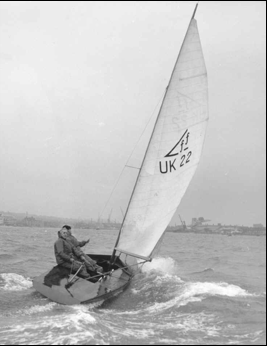
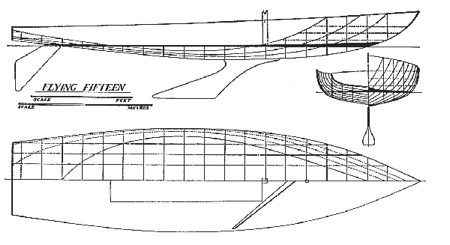
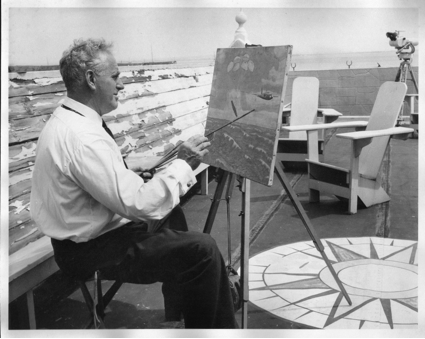
Above, Uffa Fox painting the “The Launching of an Airborne Lifeboat” in the rooftop garden of his Cowes home during the 1960’s
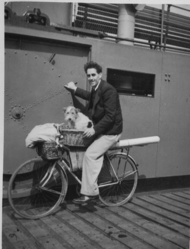
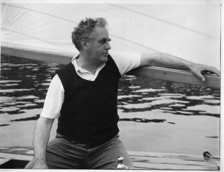
Left As a young designer with Molly, at his floating workshop.
and, Right on board Coweslip, eyes closed, a quiet day, or perhaps “getting the feel” of the boat.